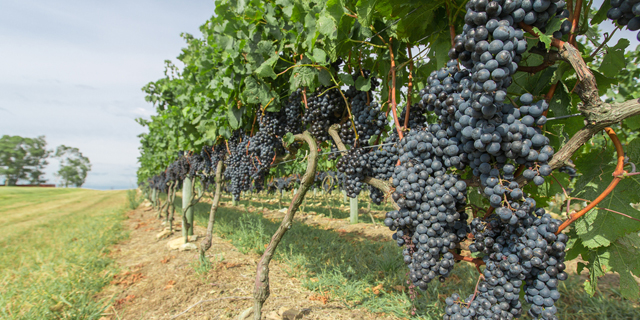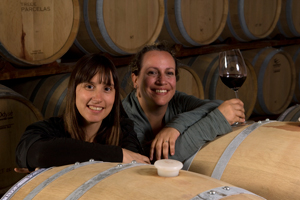Supermodels flock to Uruguay’s Punte del Este, but a new breed of super-woman is raising the bucolic South American nation’s profile, one vineyard at a time. Women are making waves—and wine—in Uruguay’s male-dominant winemaking world. Meet four Uruguayas who are rocking the vineyards with a modern approach to winemaking.
Karina Chiappella, enologist, Bodega J. Chiappella
When Karina Chiappella started enology school in her native Uruguay back in 2000, she had the dubious honor of being the only female student in her class. Chiappella, who is a third generation winemaker, started working for Bodega J. Chiappella, the family winery, at a young age.
“My father would take me and my sister to winemaking association meetings and the other men would ask him why he was bringing women to the meetings,” Chiappella recalls. “He would tell them, ‘It’s not my fault I had daughters. If they want to work in the wine industry, it’s their decision.’”
Chiappella and her younger sister wear many hats as winemakers for their family’s business, which is located in Uruguay’s Canelones region. They collaborate on creating blends, analyzing the wine through the fermentation and aging process, working the harvests and planning for future vintages.
Bodega J. Chiappella’s signature wine is the Tannat-Cabernet Sauvignon blend, which is aged in American oak and displays intense violet hues. Blackberry and vanilla flavors along with caramel and rose petal aromas make this wine a good match with grilled or stewed lamb.
Next, two more Uruguayans blazing a trail for female winemakers…
[pagebreak]Valeria Chiola, enologist, Bodega Narbona
“We’re a nation of 20 million cows and 3 million inhabitants, yet we’re among the highest wine-consuming countries in the world,” says Valeria Chiola of her native Uruguay.
Chiola first felt the calling to become a winemaker when she was a little girl, not surprising given that her grandfather was a winemaker. After completing her enology degree in Uruguay, she earned a master’s in microbiology and completed an internship at a Napa Valley winery.
Today, Chiola is chief winemaker at Bodega Narbona, located in Uruguay’s Carmelo region. Chiola defines her winemaking style as terroir-driven. “I’m passionate about the vineyard and the effects of different soils on the vines.”
As for the role of women in Uruguay’s male-dominated wine industry, Chiola says that “a lot of Uruguay’s best wines are made by Uruguayan women.” In fact, a group of Uruguayan female winemakers is about to launch their own women winemakers’ association, according to Fabiana Bracco, export manager for Narbona.
In the meantime, Bracco and Chiola enjoy tasting wines with a group of fellow women winemakers, but their tasting notes are far from technical. “We compare wines with actors,” Bracco describes. “We had a Pinot Noir that was like Hugh Grant, mysterious and elegant. Then we had a Tannat that was bold like Antonio Banderas.”
Analia Lazaneo and Valentina Gatti, winemakers, Artesana Winery
Analia Lazaneo believes fate led her to a winemaking career. She was studying agriculture at Uruguay’s Universidad de la República but switched to enology after noticing a flier on campus announcing registration for the university’s winemaking program. “I had no idea you could study winemaking,” Lazaneo says. “I still thank whoever posted the flier!”
Lazaneo was recruited to make wine by Blake Heinemann, the American owner of Artesana winery in Uruguay’s Canelones region. Lazaneo introduced fellow winemaker Valentina Gatti to Heinemann. “When Blake gave free reign to two women to make wine for him, we couldn’t believe it,” exclaims Lazaneo.
“Up until a few years ago, there were very few women enologists,” Gatti continues. “But each year you see more of a feminine presence.”
Gatti was drawn to winemaking because she’d always had an interest in chemistry, and she dreamed of a career that would allow her to work outdoors. “Winemaking was the best of both worlds,” she says.
Artesana’s 2011 Tannat is made from 100 percent Tannat grapes. Tannat is known for its bold tannins, but Artesana’s Tannat boasts a smoother, more elegant feel. Ripe black fruit with a touch of spice adds character.



![Making Mealtime Matter with La Familia: Easy Sofrito [Video]](https://thelatinkitchen.com/wp-content/uploads/2015/10/sofrito-shutterstock__0-500x383.jpg)
![Easy Latin Smoothies: Goji Berry Smoothie [Video]](https://thelatinkitchen.com/wp-content/uploads/2015/12/goji_berry-shutterstock_-500x383.jpg)
















![Fun and Fast Recipes: Fiesta Cabbage Salad [Video]](https://thelatinkitchen.com/wp-content/uploads/2015/11/fiesta_cabbage_slaw-shutterstock_-500x383.jpg)









